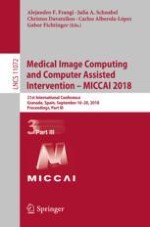2018 | OriginalPaper | Chapter
Deep Convolutional Networks for Automated Detection of Epileptogenic Brain Malformations
Authors : Ravnoor S. Gill, Seok-Jun Hong, Fatemeh Fadaie, Benoit Caldairou, Boris C. Bernhardt, Carmen Barba, Armin Brandt, Vanessa C. Coelho, Ludovico d’Incerti, Matteo Lenge, Mira Semmelroch, Fabrice Bartolomei, Fernando Cendes, Francesco Deleo, Renzo Guerrini, Maxime Guye, Graeme Jackson, Andreas Schulze-Bonhage, Tommaso Mansi, Neda Bernasconi, Andrea Bernasconi
Published in: Medical Image Computing and Computer Assisted Intervention – MICCAI 2018
Publisher: Springer International Publishing
Activate our intelligent search to find suitable subject content or patents.
Select sections of text to find matching patents with Artificial Intelligence. powered by
Select sections of text to find additional relevant content using AI-assisted search. powered by
